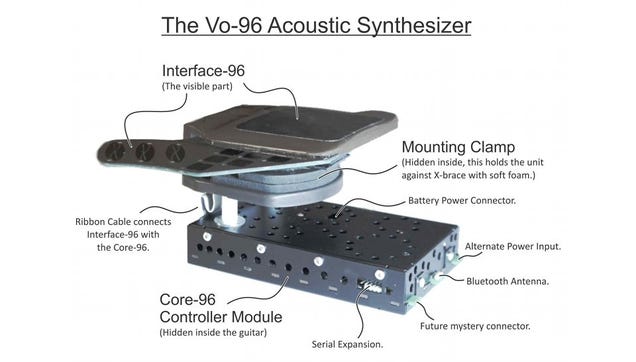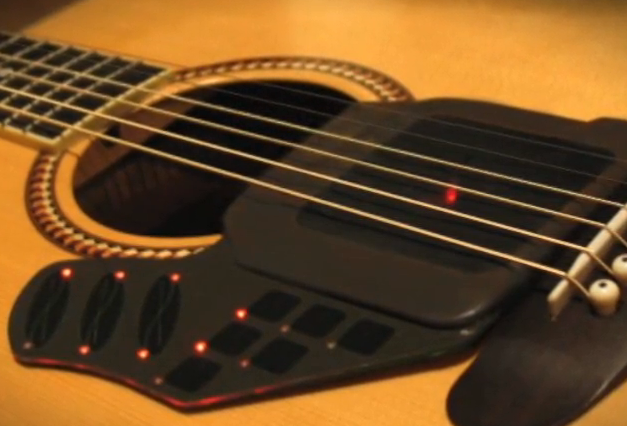 |
| 1930's Vivitone Electric |
Witness the Vivitone guitar by Lloyd Loar, the Dobro by the Doperya brothers,all the early electric guitars by various inventors and all the stomp boxes and signal processors, both analog and digital.
All were designed to make the acoustic guitar sound louder and different.
I profiled the Moog Guitar back in June 2012.
Unlike most synth guitars The Moog Guitar uses proprietary infinite sustain technology and harmonic blending to coax new and exiting sounds out of this instrument.
The Moog Guitar works best with the customized strings that give optimal sounds based on the strings metallurgy.
Unlike most synth guitars The Moog Guitar uses proprietary infinite sustain technology and harmonic blending to coax new and exiting sounds out of this instrument.
The Moog Guitar works best with the customized strings that give optimal sounds based on the strings metallurgy.
Some of you may recall the Moog Guitar was created by Paul Vo. Mr. Vo has taken guitar technology to “infinity and beyond.”
Last year Vo unveiled the concept of turning an acoustic guitar into a synthesizer with his LEV - 96. Through the new Vo – 96, Mr. Vo has taken acoustic guitar synthesis a step farther.
The battery powered Vo – 96 fits on the lower side of an acoustic guitar’s sound hole and extends to the bridge.
The Vo – 96, like its predecessor works on “vibration control technology.” The unit physically alters how the strings vibrate, creating a whole new soundscape.
 |
| Core 96 Module |
Roland technology uses the strings vibration to send signals via the hex pickup to the synth unit. The guitar becomes more of a controller.
Vo has changed the way to modify a guitars sound. This can be applied to other stringed instruments as well.
Normally magnetic guitar pickups turn the vibrations of a string into electronic signals that are then amplified.
Vo’s unit takes the vibration or waveform that the guitar string is producing and has the ability to determine 16 different harmonic partials per string.
Each string can be separately controlled. Multiply this time 6 strings and the result is the Vo-96 can control 96 harmonic channels.
All this is done in real time and creates a myriad of possible sounds.
Each string can be separately controlled. Multiply this time 6 strings and the result is the Vo-96 can control 96 harmonic channels.
All this is done in real time and creates a myriad of possible sounds.
The unit is not for sale. As of this writing, it is just a concept.
The LEV-96 is a reality, but is being beta tested by guitarists such as Phil Keaggy and Kaki King.
There are but a few requirements a user would need once the Vo-96 goes on the market.
You have a steel string flat top acoustic guitar. Your guitar should have a standard sound hole in the usual position. A standard guitar sound hole of near 4 inches in diameter is necessary. At its closest, the sound hole edge should be located at least 3 inches away from the raised wood of the bridge of the guitar.
The spacing of your strings at the bridge measured between the E1 and E6 strings should be between 2 1/8″ to 2 3/8″ or 2.125″ to 2.375″.
The guitar body must not be unusually thin. The Vo-96 reaches 3 inches down into the instrument measured from the top surface of the guitar.
The waist of the guitar – the narrowest portion of the body – must measure at least 8 1/2 inches across.
Most common acoustic guitars will meet these standards.
The one thing that could be an issue is string height. There needs to be adequate room under the strings for the Vo-96 unit. There needs to be at least a 1 centimeter clearance. This is about the width of a AAA battery.
The features of the Vo-96 include:
- 12 physical sensor actuator channels, 2 per string
- 96 virtual channels of harmonic control, 16 per string
- Capacitive touch interface with LED status indication and lock-out
- Power, harmonic blend and note duration touch-sliders
- Adjustable modulation effects with instant preset save/recall
- 6 quick-change presets in 3 sets of 2 using odd, even and all harmonics
- 3 harmonic arpeggios unique to six presets independently triggered on 6 strings
- Hex random harmonic modulation with average rate and amplitude adjust
- Hex Tremolo with separate triggers per string and rate touch-slider
- Bluetooth Wireless connectivity for firmware updates and TBD advanced features
- No moving parts - built to last as long as your guitar
- Attaches and removes without marring your guitar
- Designed to run on optional internal battery power or external power adaptor
- Optional 4/hr advanced LiFePo4 battery with integral charging
- Hardware platform has large uncommitted resources for firmware expansion
It is a very interesting concept to utilize Bluetooth Technology instead of a guitar cord connected to the amplifier or even a radio controlled signal.
Kaki King with the LEV - 96










Tidak ada komentar:
Posting Komentar